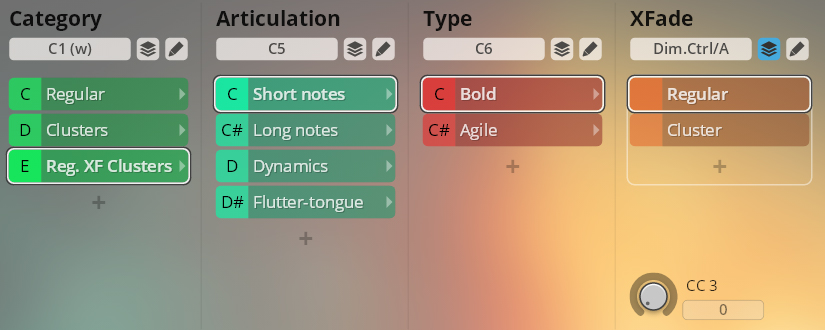BBO Woodwinds includes the full sample content of the previously available BBO Packs Neptune (Tutti Woodwinds) and Solaris (FX Woodwinds) in one easily accessible package. The comprehensive library gives you immediate access to mesmerizing woodwind ensembles – from refined tutti passages to dynamic runs, clusters, and textures.
The Precision Presets discussed in this document are what you already know if you own other VSL libraries. As opposed to our new Flow Presets, they allow you to explore the depths of the library, adjusting and tweaking parameters as you see fit. Here you can also create presets of your own and adapt them to your workflow.
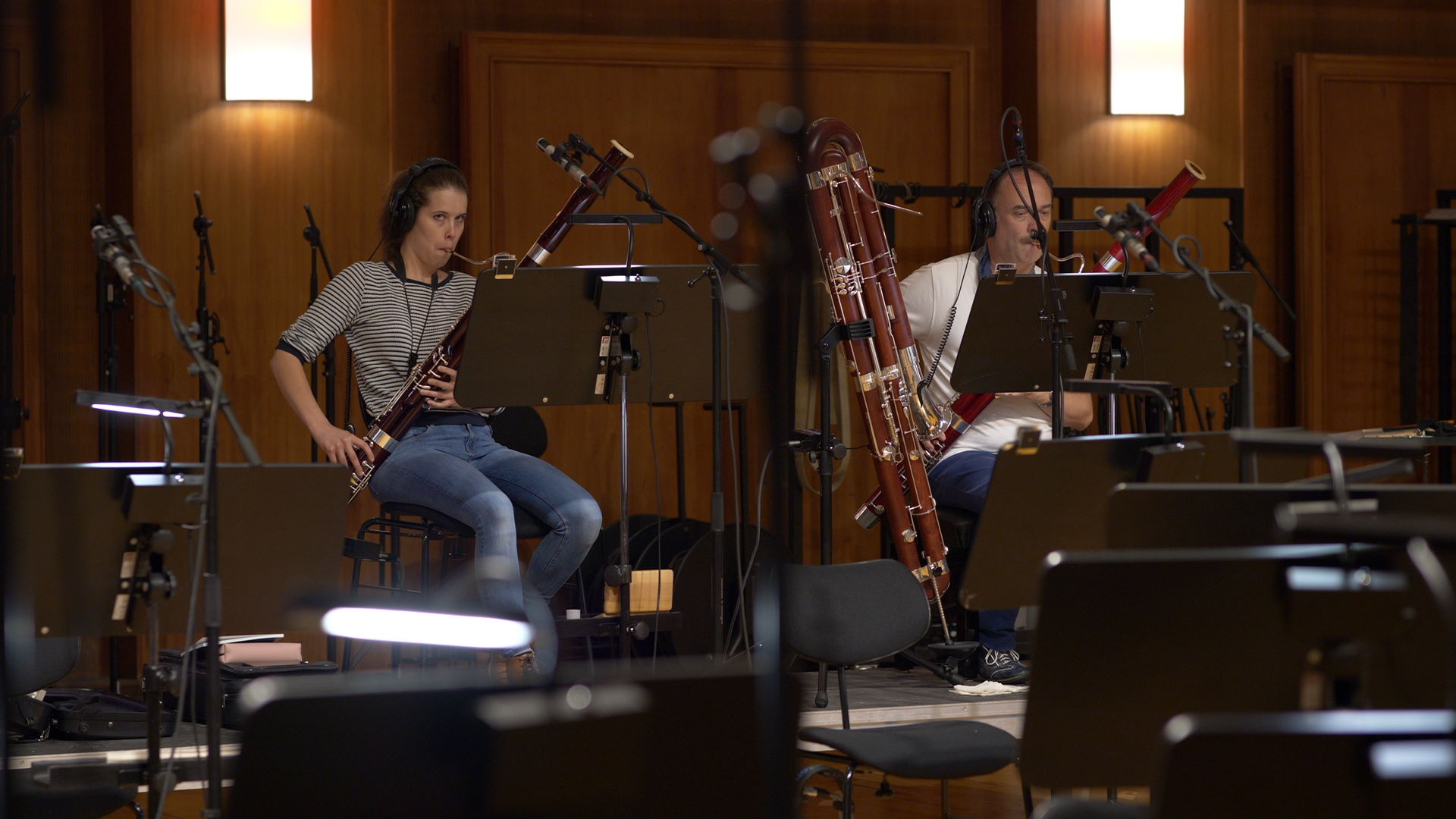
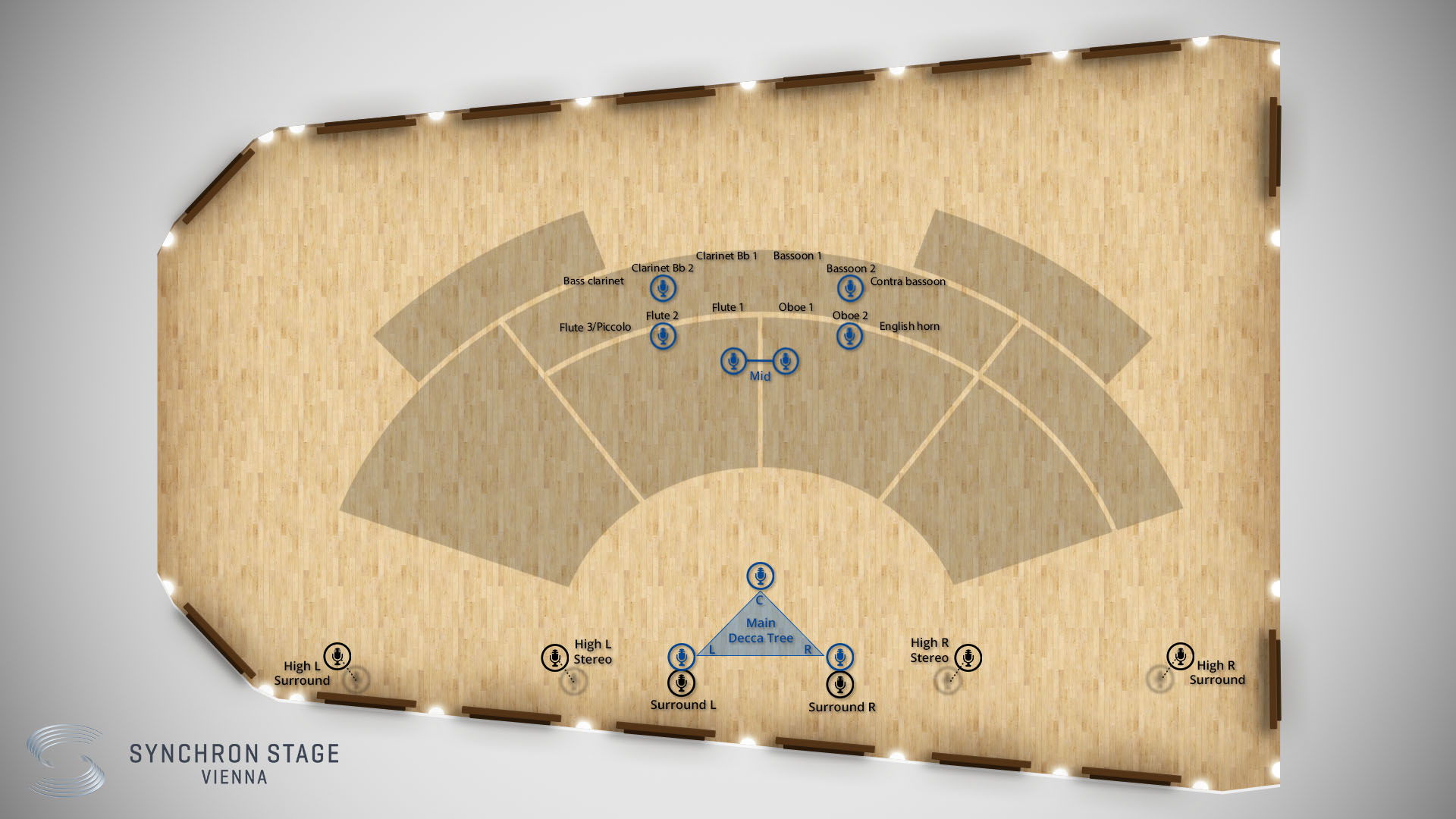
The preset offers a woodwinds tutti ensemble with 13 musicians - 1 piccolo, 3 flutes, 2 oboes and 1 english horn, 2 clarinets in Bb and 1 bass clarinet, 2 bassoons and 1 contrabassoon. The layout is the same as that of comparable presets of other libraries like BBO Brass, so that you can switch between the articulations of different libraries without having to adapt any keyswitches.
All articulations can be played with or without the piccolo flute.
Range: A#2–D6
Keyswitches
Articulation: C1–F1
Type: starting at C7
Senza / con piccolo: A0/B0
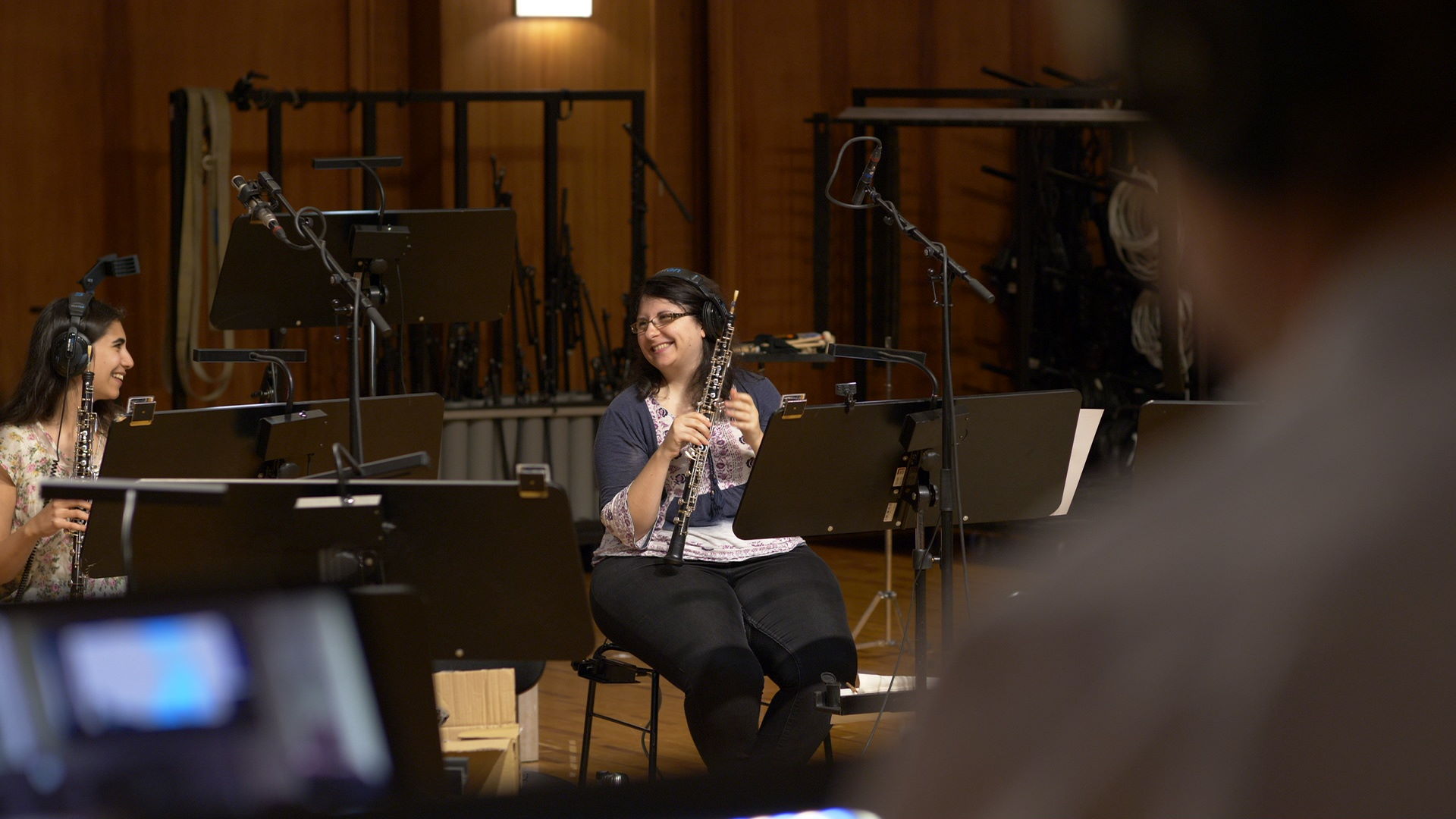
Bold and agile.
Bold/agile: C7/C#7
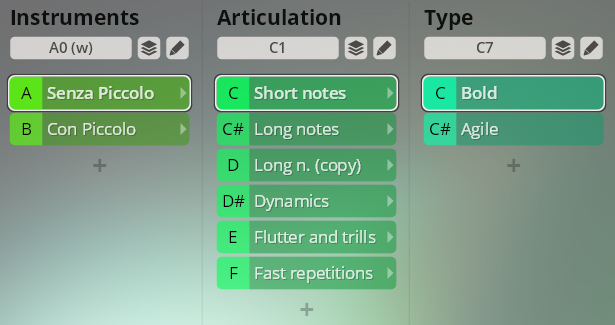
Sustained, marcato, and espressivo notes. For the sake of consistency, the following slot contains a copy of this one where other libraries' presets feature legato articulations.
The marcato option allows you to control the marcato amount of the tone with MIDI CC 3.
Type: C7–D7
Marcato: Dim.Ctrl/A (MIDI CC 3)

Sforzato, sforzatissimo, swells short and long, and soft swells.
Type: C7–E7
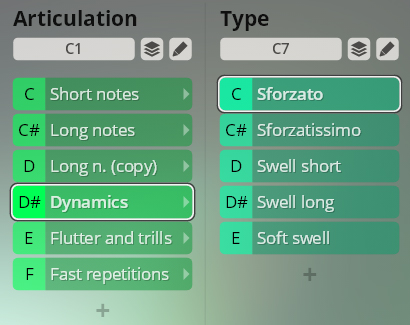
Flutter tonguing, half and whole tone trills.
Type: C7–D7

Staccato repetitions at 120, 140, and 160 BPM. These are already prepared for timestretching, i.e., all Patches have the original tempo they were recorded with entered as their source tempo. This allows you to adapt your repetitions automatically to the tempo of your project with only two mouse clicks.
Tempo: C7–D7

Long notes, octave runs in major keys and special scales, and arpeggios.
Range long notes: B3–A#6
Keyswitches
Articulation: C1–D#1
The long notes have no further options.
Octave runs up and down from C to B major, plain with ringing and cut release, and as performance octave. "Cut" release is only executed when the octave run is not completed, allowing you to attach another sample instead of the octave.
Range
Plain run: mapped to the notes of the scale starting with its base key – upward runs around the 4th and 5th octave, downward runs around the 6th and 7th octave, e.g., C Major up C4–A5, down C6–A7.
Perform octave: mapped to the notes of the scale starting with its base key, roughly spanning the 4th to the 6th octave, e.g., C Major C4–A6.
Keyswitches
Key selection: C2–B2
Plain run/perform octave: C3/D3
Ringing/cut release: F3/G3
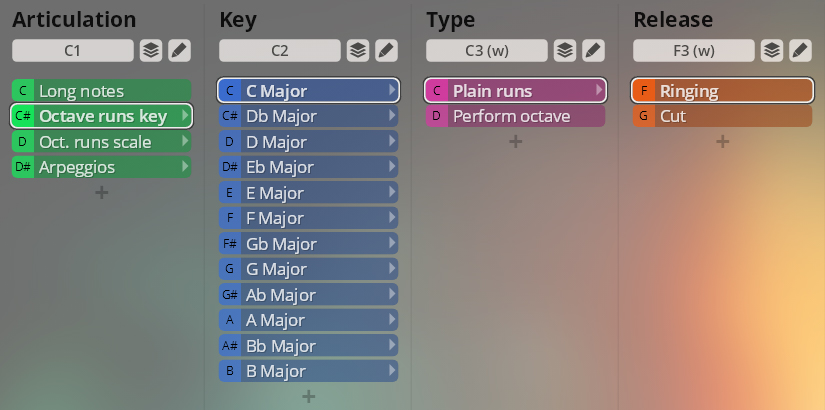
Perform octave
An actual octave run has to be completed in order to trigger its execution. The advantage compared with "plain" runs is that it allows you to time exactly when after a sustained starting note the run should begin.
Octave runs up and down, plain with ringing and cut release, and as performance octave: Ionian/Major, Dorian, Phrygian, Lydian, Mixolydian, Aeolian/Minor, Locrian, chromatic, and whole tone. "Cut" release is only executed when the octave run is not completed, allowing you to attach another sample instead of the octave.
Range
Plain run: upward runs around the 4th and 5th octaves, downward runs around the 6th and 7th octaves, e.g., Ionian/Major up B3–A#5, down B5–A#7.
Perform octave: roughly spanning the 4th to the 6th octave, e.g., Ionian/Major B3–A#7.
Keyswitches
Mode selection: C2–G#2
Plain run/perform octave: C3/D3
Ringing/cut release: F3/G3

Perform octave
An actual octave run has to be completed in order to trigger its execution. The advantage compared with "plain" runs is that it allows you to time exactly when after a sustained starting note the run should begin.
Up, down, and cross arpeggios at 80/100/120 BPM, major, minor, dominant 7, major and minor 7, minor with major 7th, diminished, and augmented. These are already prepared for timestretching, i.e., all Patches have the original tempo they were recorded with entered as their source tempo. This allows you to adapt your repetitions automatically to the tempo of your project with only two mouse clicks. "Cut" release is only executed when the arpeggio is not completed, allowing you to attach another sample instead of the arpeggio's end note.
Range: C4–A#5
Keyswitches
Tempo selection: F1–G1
Chord type: C2–G2
Up/down/cross: C3/D3/E3
Lowest/highest/cut release note: F3–G3

Cross arpeggios
Ringing/cut release: F3/G3
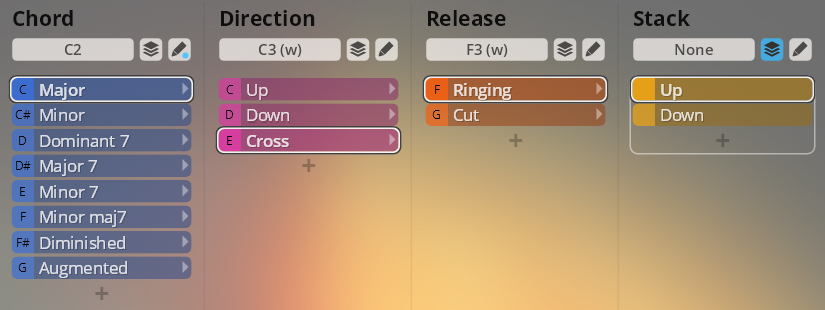
Regular and cluster tones, and crossfades between the two.
Range: A#1–D4
Keyswitches
Articulation: C5–D#5
Short and long notes, dynamics, and flutter tonguing. The latter has no additional types.
Short
Bold/agile: C6/C#6
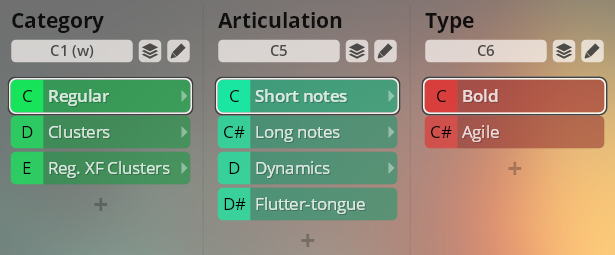
Long
Sustained notes, regular, espressivo, and with soft swell.
Type: C6–D6
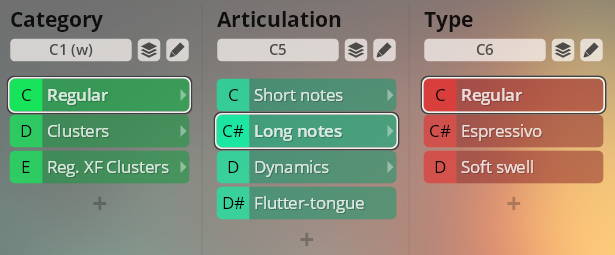
Dynamics
Sforzato, sforzatissimo, and short and long swells.
Type: C6–D#6
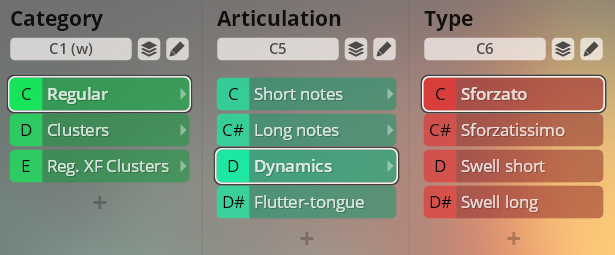
Crossfading between regular and cluster variants with Dim.Ctrl/A (MIDI CC 3) for crossfading between regular and cluster articulations. These feature the same types as their namesakes in the other two categories.
Type keyswitches
Short notes: C6–C#6
Long notes: C6–D6
Dynamics: C6–D#6
Regular/cluster XF: Dim.Ctrl/A (MIDI CC 3)
